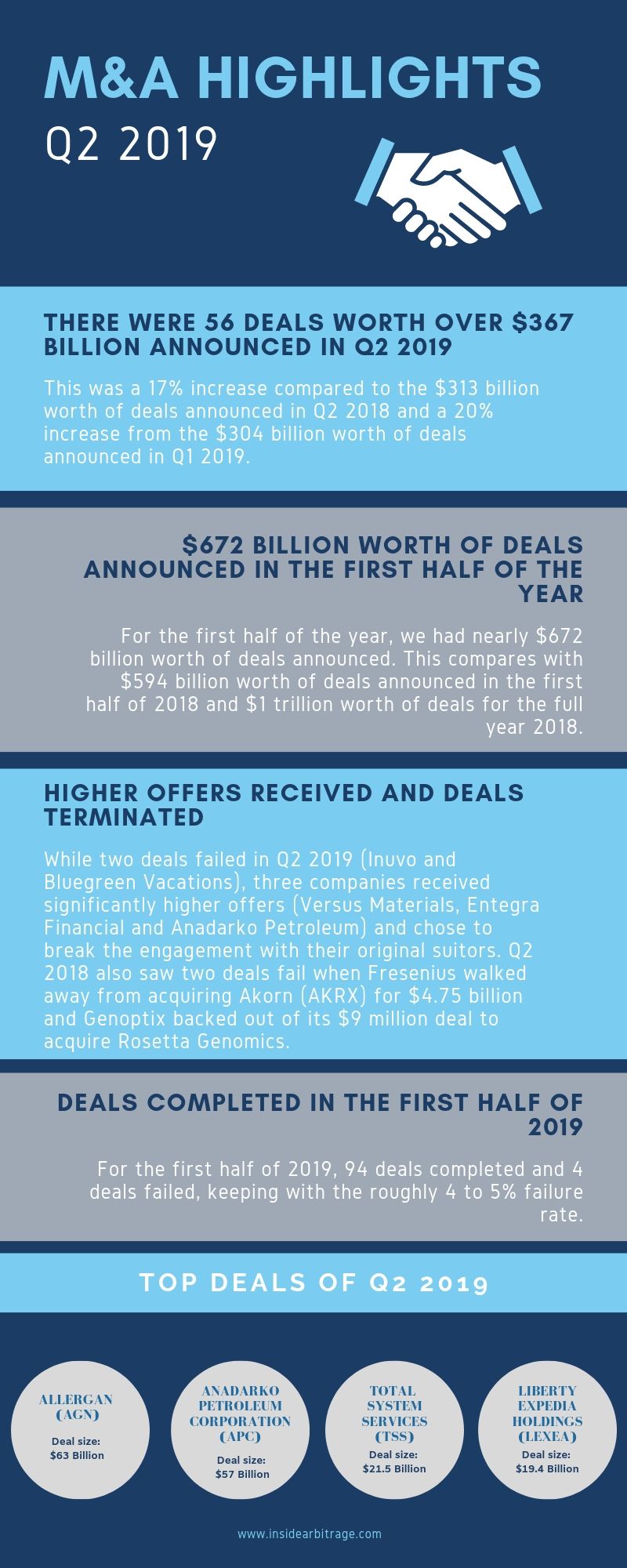US Mergers and Acquisitions: A Q2 2019 Report
A few weeks ago when we were working on our weekly article about mergers, I noticed that in a single week over $100 billion in U.S. mergers and acquisitions had been announced. The end of the second quarter of 2019 ended equally strong with 12 new deals announced worth over $85 billion thanks to the mega merger of Allergan (AGN) with AbbVie (ABBV). This made me wonder if this was an unusually strong quarter for deal making or just par for the course with a couple of strong weeks. Trying to answer that question led to the creation of this article and we plan to start reporting on the state of US mergers and acquisitions once a quarter.
We decided to mine our database of deals to look at both the number of new deals announced in Q2 2019 and the aggregate size of those deals to see how they compared with the same period last year (Q2 2019) and the prior quarter (Q1 2019). Here are some highlights from our analysis in an infographic our analyst put together. Since this is the first infographic we have put together, you will have to forgive us for any glaring infographic faux pas.

With worries about further interest rate increases replaced by expectations of interest rate cuts by the fed and corporate coffers flush with cash after the big corporate rate tax cut, it makes sense that both private equity firms and corporations have stepped up their deal making.
What really surprised me was the failure rate for deals, which felt like it was higher this year but turned out to be consistent with the roughly 4% to 5% failure rate we have reported in our prior research here and here. Tight spreads for most deals, long drawn out regulatory approvals and a drop in the price of certain acquisition targets that once appeared safe were some of they key challenges arbitrageurs faced this year. On the positive side, we also saw several deals where new higher offers prevailed.
The six active deals with the largest spreads including Genworth (GNW), Pacific Biosciences of California (PACB), LSC Communications (LKSD), Stewart Information Services (STC), Spark Therapeutics (ONCE) and Sprint (S) all have one thing in common: regulatory risks. The nature of those regulatory risks vary for each of those deals including antitrust review by the DOJ and a review by the FCC for Sprint’s merger with T-Mobile (TMUS), a state regulator’s disapproval of Fidelity National Financial’s acquisition of Stewart Information Services (STC) and the equivalent of the FTC in the United Kingdom referring Illumina’s acquisition of PacBio (PACB) for a phase 2 review.
Even when it looks like all regulatory approvals are in, you have situations like that of IBM’s acquisition of RedHat where Brazil revoked its approval right after the European Union approved the deal. The deal was eventually consummated this week and closed sooner than expected as discussed in a premium post we published earlier this week. There are always risks and they are usually readily evident from the spread on the deal and the direction of the spread. A good example of this is the acquisition of Spark Therapeutics (ONCE) by Roche, which started the second quarter with a very narrow spread of just 0.43% but that spread had widened to 11.84% by the end of the quarter. The spread increased some more this week after Roche and Spark Therapeutics decided to extend the deadline of their merger agreement to April 30, 2020.

This Goldilocks economy is perfect for deal making with interest rates low because of international pressures (the trade wars and low/negative rates in Europe) and the domestic consumer remains strong after years of low unemployment. If these conditions persist through the end of the year, we are likely to see this elevated pace of deal making despite the fact that valuations continue to creep higher.
We plan on tracking all deal activity in the U.S. this quarter and report on it every week as well as at the end of Q3 2019 in our new quarterly report on the state of U.S. mergers and acquisitions.
Voluntary Disclosure: I hold a long position in Pacific Biosciences of California (PACB).
